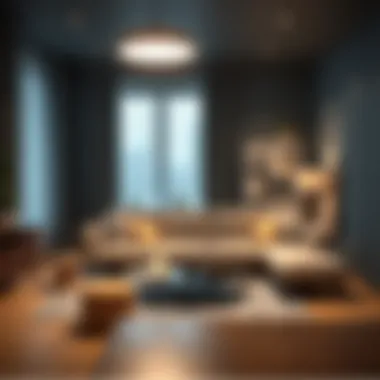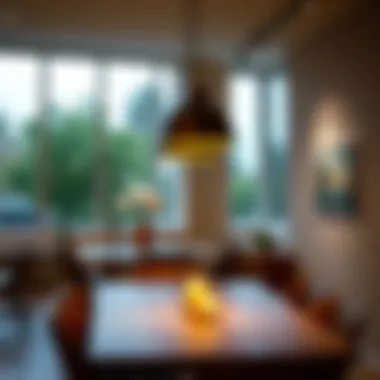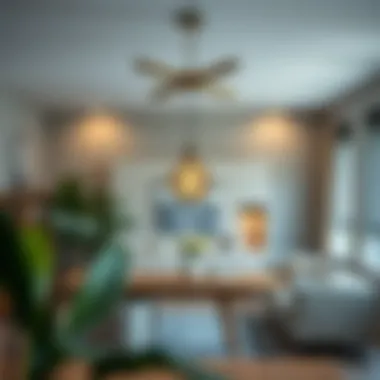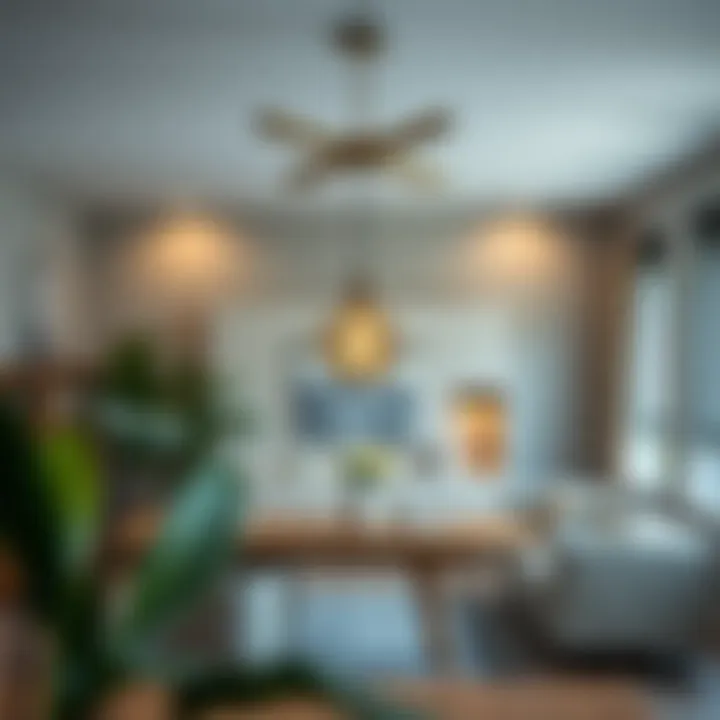Cost-Effective Lighting Ideas for Every Space


Intro
In today’s fast-paced world, creating a warm and inviting atmosphere in homes and workplaces doesn’t have to come with a hefty price tag. Recognizing the critical role of lighting in defining spaces, we dive into a spectrum of economical lighting solutions that enhance both aesthetics and functionality. Whether you are a homeowner looking to make a cozy corner or a designer pushing for innovation on a budget, understanding lighting can dramatically change the vibe of a space.
The journey through this article unfolds various energy-efficient technologies and innovative design choices, aiming to equip you with the know-how to enhance interiors without succumbing to financial strain. As we explore current trends and practical buying guides, we will shed light on how selecting the right fixtures contributes significantly to any decor’s ambiance. Lighting is a blend of art and science, and this comprehensive guide will navigate through the essentials, offering insights fitting for retail shoppers, DIY enthusiasts, and professional designers alike.
Design Trends
Current Trends in Lighting Styles
Shifting away from traditional incandescent bulbs, contemporary lighting trends emphasize energy efficiency and sleek design. LED lights have taken rooftops and ceilings by storm, known not just for their longevity but also for their compatibility with smart home technologies. Moreover, the warmth and cooler tones available in LEDs now offer flexibility in creating the perfect ambiance – be it a calm workspace or lively gathering area.
On the design side, minimalist fixtures are trending. Clean lines and simple structures often accentuate existing decor rather than overshadow it. Think geometric shapes or pendant lights made from natural materials like bamboo or recycled metal. These touches don’t just save on costs – they also resonate with the growing emphasis on sustainability.
How to Incorporate Trends into Your Space
To truly harness the benefits of lighting designs, consider the following tips:
- Layer Your Lighting: Combine ambient, task, and accent lighting in a room to ensure it’s both functional and aesthetically pleasing. This way, you can create a versatile environment suitable for different times of the day or activities.
- Choose Colors Wisely: The hue of your bulbs can significantly impact a room's mood. Opt for warmer shades for cozy spaces and cooler tones for areas meant for concentration.
- Utilize Dimmers: Dimming lights can enhance the environment by allowing for adaptability depending on the occasion, saving on energy bills in the process.
By keeping an eye on emerging trends and having a few tricks up your sleeve, any space can be transformed, showcasing personality while being mindful of expenses.
Buying Guides
Choosing the Right Lighting for Different Rooms
Selecting the appropriate lighting can be a daunting task when faced with numerous options. Here are specific recommendations for different areas:
- Living Room: Consider floor lamps or stylish wall sconces to create a warm ambiance. A large statement chandelier can anchor the space.
- Kitchen: Bright task lighting is essential here. Under-cabinet lighting can illuminate workspaces without creating glare.
- Bedroom: Soft lighting options are preferable. Dimmable bedside lamps can create intimate moments and offer sufficient light for reading.
Tips for Assessing Quality and Value
When shopping for lighting fixtures, it’s essential to focus on quality to ensure lasting value. Adopt these strategies before making a purchase:
- Research Manufacturer’s Reputations: Stick to brands recognized for their durability and efficient customer service. Look at reviews on websites like Reddit or on manufacturer’s pages.
- Check for Energy Efficiency Ratings: Products with higher efficiency ratings often yield savings on electricity bills in the long run.
- Consider Warranty and Return Policies: Evaluate warranties offered on products. A generous policy can save headaches down the road.
By understanding trends and practically evaluating your options, improving your lighting situation becomes an art form that anyone can master without bleeding their wallets dry.
Understanding the Importance of Lighting
Lighting is an essential aspect of our living and working spaces, influencing not just visibility but also the mood and functionality of an environment. When we delve into the realm of economical lighting solutions, it becomes clear that the right choice can transform a space dramatically without breaking the bank. It's more than just illuminating a room; it's about how we use light to create feelings, enhance products, and support activities.
One must understand that lighting serves multiple purposes. It can enhance or detract from the ambiance, subtly guiding how we perceive a space. Proper lighting can create a welcoming atmosphere, while poor choices can leave a room feeling cold and uninviting. Homeowners and designers need to grasp this to optimize the functionality of interiors, as well as to elevate aesthetics.
For instance, consider a living room. With cream-colored walls, the right lighting can make the space feel cozy, inviting, and warm. A poorly chosen overhead light, on the other hand, can wash out the color and make the space feel bland and lifeless. So, understanding the nuances of lighting is key to achieving the desired effect in any setting.
"The right kind of lighting can take a plain room and turn it into a world of comfort and style."
Moreover, lighting also has practical implications. It affects how we interact with our spaces and can enhance our productivity levels. For workspaces, appropriate lighting, especially task lighting, can significantly boost concentration and efficiency. If a home office is dimly lit, distractions seem higher, energy levels plummet, and motivation wanes. Thus, the balance between functionality and aesthetics is not just important; it is essential.
The Role of Lighting in Interior Design
Interior design fundamentally relies on lighting to set the tone and style of a space. Designers emphasize the careful selection of lighting as a core element, equal to color schemes and furniture placements. When taking a holistic view, lighting interacts with texture, color, and space to create an immersive experience. Think of a restaurant with soft, warm lights that cast gentle shadows on elegantly arranged tables; it’s designed to make patrons feel relaxed and enticed to linger. This interplay illustrates how crucial lighting is in creating a targeted atmosphere.
Creating Ambiance with Lighting
Creating ambiance through lighting is akin to painting with broad strokes. It establishes an emotional backdrop, guiding how individuals feel once they walk into a space. Consider a cozy reading nook: the use of warm, dimmable bulbs can evoke a sense of serenity, making it an ideal place for relaxation and unwinding. In contrast, bright, white lights may be used in kitchen designs to ensure functionality while cooking. This duality between ambient versus task lighting is what designers often play with to enhance overall experience.
Functional Versus Aesthetic Lighting
The balance of functional and aesthetic lighting cannot be understated. Functional lighting serves practical needs; it’s what allows us to see well enough to perform tasks. On the other hand, aesthetic lighting is purely about the visual impact. Think about how a chandelier might become the centerpiece of a dining room, drawing the eye upward. Yet, it’s also about seeing the food clearly during meal times. This is where the art of lighting comes into play—finding that sweet spot where beauty meets utility. Designers urge homeowners to consider both aspects when choosing lighting solutions, aiming for a marriage that enhances both design appeal and functionality.


Types of Cost-Effective Lighting Options
In the quest for a well-lit space that aligns with aesthetic and functional needs, exploring cost-effective lighting options is essential. These alternatives not only help manage expenses but also support energy conservation efforts. The importance of this topic lies in understanding the spectrum of choices available, which include a mix of traditional and modern approaches. Each option comes with unique benefits and considerations, making it vital to evaluate how they can directly affect energy usage, ambiance, and overall interior design. With the right selections, one can illuminate their surroundings without breaking the bank.
Incandescent Bulbs: A Classic Choice
Traditional incandescent bulbs have held their ground in many households. These bulbs provide a warm glow, reminiscent of vintage charm, which many people find appealing. They are relatively inexpensive to purchase and are widely accessible. However, there are downsides to consider. Incandescents are far from energy-efficient; they convert most of the energy they consume into heat rather than light. Although suitable for short-term use, relying on them long-term can lead to inflated electricity bills. For those on a tight budget, they might be tempting, but it's worth considering their longevity compared to modern alternatives.
Energy-Efficient LEDs
LED lights, or light-emitting diodes, have revolutionized how we think about lighting. Known for their superior energy efficiency, they consume up to 75% less energy than traditional incandescent bulbs while lasting much longer. Installing LEDs can notably reduce energy costs over time, making them a wise investment. Moreover, these lights come in a variety of colors and styles, allowing homeowners and designers to select fixtures that blend seamlessly with any decor.
"Switching to LED lighting may save up to $225 in energy costs over the lifetime of a bulb."
This investment pays off, especially when you consider that many LEDs come with warranties that range from 2 to 5 years, making them reliable solutions for both casual and professional settings.
Fluorescent Lights: Pros and Cons
Fluorescent lights are often found in commercial settings due to their efficiency and brightness. They use less electricity than incandescent bulbs and are suitable for large areas, making them a cost-effective option for offices and retail spaces. However, they might not suit every atmosphere. Fluorescents tend to emit a colder light, which can feel harsh in a more intimate or home setting. Also, they contain small amounts of mercury, which presents disposal concerns. The trade-off here involves balancing energy efficiency with the right ambiance and safety considerations.
Smart Lighting Solutions
In today’s tech-savvy world, smart lighting is gaining traction for more than just its convenience. These systems allow users to control lighting via smartphones or voice commands, bringing flexibility to light management. Smart lighting often includes LED bulbs, which enhances their energy efficiency. Compounded benefits arise from features such as dimming, scheduling, and motion sensors, which can further lower energy costs when implemented effectively. For those concerned about future-proofing their home or workspace, investing in smart lighting is a progressive step that seamlessly blends cost-effectiveness with modern convenience.
Choosing the Right Lighting Fixtures
Selecting the appropriate lighting fixtures is a cornerstone of effective lighting design. The right fixtures not only illuminate a space but can also uplift the mood and influence the overall aesthetic. Poor choices, on the other hand, can render your efforts moot, leaving a space feeling disjointed or even uninviting. Thus, the process of choosing lighting fixtures should be approached with a discerning eye and a clear understanding of the environment you are working with.
Consider Your Space
When contemplating lighting fixtures, the very first thing to bear in mind is the nature of your space. Dimensions, ceiling height, and the overall layout play crucial roles in dictating what type of fixtures would be beneficial. For example, a compact room might benefit from wall-mounted sconces or pendant lights that draw the eye upward, creating the illusion of height.
Conversely, large open areas often require more robust solutions. Think about the placement of furniture and how light will interact with these objects. It’s critical to ensure that fixtures enhance usability without creating glare or deep shadows. Consider the following:
- Room Size: A larger space may call for multiple fixtures or a single statement piece.
- Purpose of the Space: Kitchens and work areas might demand bright, focused light, while living rooms often require soft ambient light.
- Layout Considerations: How does light flow in your space? Does it create a warm, inviting atmosphere?
Matching Fixtures to Decor Styles
The world's variety in decor styles offers an endless playground for creativity. However, mismatched lighting can clash with your carefully curated space. It’s essential to ensure your fixtures harmonize with the decor style, whether it's minimalist modern, rustic chic, or mid-century retro. You wouldn’t want a sleek, stainless-steel fixture hanging in a cozy, farmhouse-style kitchen. Instead, consider these pairings:
- For Modern Spaces: Opt for clean lines and metallic finishes. Pendant lights with geometric shapes work wonders.
- For Traditional Designs: Look for ornate chandeliers or classic lantern styles that evoke a sense of history.
- For Eclectic Styles: Feel free to mix and match. Vintage fixtures can coexist with modern elements, creating a playful contrast.
Choosing the right lighting is akin to selecting accessories for an outfit; the wrong piece can overwhelm the entire look.
Understanding Light Distribution
Light distribution is not merely a technical term; it reflects how light spreads across a space and directly impacts usability and ambiance. Not every room needs bright, uniform light. Instead, varying light levels and types can create depth and dynamic interest. Understanding how to balance different lighting elements is crucial.
- Direct Lighting: Provides focused light, perfect for tasks such as reading or cooking. Think of track lights or adjustable desk lamps.
- Indirect Lighting: Softens a room by bouncing light off walls or ceilings, often used effectively in home theaters or lounges.
- Ambient Lighting: The overall light in a room, achieved through overhead fixtures or lamps. It should be soft enough to not overwhelm the senses yet bright enough to navigate comfortably.
In summary, taking the time to strategically select the right lighting fixtures can transform a space significantly. Whether it's considering the dimensions of the area, matching styles with thoughtful precision, or paying attention to how light behaves within that environment, these considerations make all the difference in creating an inviting, efficient, and aesthetically pleasing setting.
Innovative Lighting Techniques
Innovative lighting techniques play a pivotal role in optimizing both the functionality and aesthetic appeal of any space, be it residential or commercial. As we seek to devise economical lighting solutions, it's crucial to understand the various creative strategies that can be employed to enhance an area's atmosphere without breaking the bank. The beauty of innovative lighting lies in its versatility, allowing homeowners and designers to craft unique ambiences tailored to the mood and purpose of their settings.
These techniques can significantly elevate ordinary spaces, making them more inviting and visually striking. Additionally, they often coincide with energy-efficient practices, contributing to long-term savings on utility bills. In this section, we will explore three notable approaches: layering light to create depth, accent lighting for enhanced focus, and the effective integration of natural light.
Layering Light: A Multi-Dimensional Approach
Layering light is about balancing three fundamental components: ambient, task, and accent lighting. This method goes beyond merely hanging a bulb or installing a fixture; instead, it involves a calculated approach to illumination that cultivates depth and richness in a space. Ambient lighting provides the general, even glow necessary for basic visibility, while task lighting focuses on areas where activities take place, like a reading nook or kitchen workspace.


Furthermore, accent lighting is employed to highlight artwork or architectural features, drawing attention and adding personality to the environment. When effectively layered, these three elements work harmoniously, allowing for functional and visually appealing spaces that can adapt to various needs and occasions.
- Benefits of Layering Light:
- Enhances the overall aesthetics of a room.
- Offers flexibility to adjust mood and atmosphere easily.
- Helps to pinpoint areas needing specific light, improving utility and usability.
By thoughtfully applying this technique, you can redefine an area’s character, creating a dynamic space that resonates with its inhabitants.
Accent Lighting for Visual Interest
Accent lighting serves as the cherry on top of the cake, delivering flair and focus to specific areas or objects within your space. It goes beyond merely lighting up; it’s about directing attention. Think about a well-placed floor lamp that casts a warm glow on a late-night reading corner or the fairy lights strung along a photo wall that draw the eye and spark conversation.
This type of lighting is not only practical but also crucial for layering effects. When you highlight particular features, you add dimension and intrigue to an otherwise flat room.
- Common Sources of Accent Lighting:
- Track lighting to spotlight features or artwork.
- Wall-mounted fixtures to enhance a room’s vertical planes.
- Table lamps strategically arranged to create focal points.
Accent lighting enriches your space with a personal touch, making it more than just functional.
Natural Light Integration
In a world of rising electricity costs and the fast-paced lifestyle that often shuns outdoor exposure, the integration of natural light emerges as a remarkable economical lighting technique. Harnessing sunlight not only reduces reliance on electric bulbs but also brings a slice of the outdoors inside, which fosters well-being and enhances mood.
Options for integrating natural light include the thoughtful arrangement of windows, the use of light tubes, and the installation of skylights, all aimed at maximizing daylight influx.
Consider the following to make the most of natural light:
- Use lighter tones in your decor to reflect incoming light.
- Place mirrors across windows to bounce light deeper into the room.
- Avoid heavy drapes that block sunlight; opt for sheer fabrics instead.
Integrating natural light creates an inviting environment that can uplift spirits and enhance creativity, proving both a practical and aesthetic choice.
In the quest for economical lighting solutions, these innovative techniques serve as vital tools, allowing for the realization of beautifully lit spaces without straining budgets.
Budget-Friendly Lighting Ideas
In the world of interior design, lighting is often an overlooked element. Yet it holds the key to transforming a space, adding character and functionality while ensuring the overall aesthetic resonates with its users. Budget-friendly lighting ideas play a pivotal role in making these transformations accessible, allowing homeowners and designers to strike the perfect balance between cost and creativity. Not only can well-planned lighting serve practical purposes, such as illuminating key areas, but it can also serve as a statement piece that captures the eye without breaking the bank.
Consider this: updating your space doesn’t always require a hefty financial commitment. Instead, smart choices can lead to impressive changes, all while adhering to a strict budget. Budget-friendly solutions can range from DIY projects to hunting down the best deals on quality fixtures, each offering a wealth of benefits that many might overlook in their pursuit of style and functionality.
DIY Lighting Projects
When it comes to saving money, rolling up your sleeves and getting crafty can be a fantastic solution. DIY lighting projects not only save cash but also allow for personalization, reflecting individual tastes. Think of the thrill of creating something one-of-a-kind that serves a purpose in your home.
For those unacquainted with the craft, here are some easy projects to consider:
- Mason Jar Pendant Lights: Repurpose those jars collecting dust. With some wire, a light bulb fixture, and a little elbow grease, you can create charming pendant lights that add rustic appeal to any kitchen or dining area.
- Wine Bottle Table Lamps: Those empty bottles from your last gathering? With minimal tools, you can turn them into unique lamps. Just add a lamp kit, and you have a conversation starter right on your side table.
- Paper Lanterns: With origami skills or simple folding techniques, you can easily craft beautiful paper lanterns. These can provide softer, ambient lighting ideal for cozy evenings.
Not only are these projects budget-friendly, but they can also provide a sense of fulfillment and accomplishment.
Repurposing Existing Fixtures
Another clever strategy for cost-effective lighting is repurposing existing fixtures. Before tossing out old lamps or chandeliers, consider how they can be revitalized. A little creativity can breathe new life into what might seem like outdated lighting options.
Here are a few ideas:
- Repainting Old Lamps: A fresh coat of paint on a boring lamp shade can completely change its vibe. Choose colors that contrast or complement your decor for a seamless fit.
- Changing the Bulbs: Swapping standard bulbs for more energy-efficient LED ones not only saves money over time but can also brighten your space in unexpected ways. Sometimes it's all about the brightness and tone of the light!
- Adapting Fixtures for New Uses: Take an old ceiling fixture and turn it into a stylish wall sconce by simply hanging it differently. Your imagination is the limit.
Through repurposing, you can ensure less waste while saving a significant sum, and you might just create something stunning in the process.
Finding Discounts on Lighting Products


Even with DIY projects and repurposing, some might still seek ready-made solutions. This is where the art of finding discounts becomes invaluable. The market is teeming with options that can cater to both aesthetics and budget.
Here are some tips for snagging the best deals:
- Shop off-season: Just like fashion, lighting has seasons. Consider purchasing lights during holiday sales or clearance times when inventory is being rotated.
- Utilize Online Marketplaces: Websites like eBay or Craigslist often have gently used or even new lighting products at a fraction of retail prices. Always ask for photos and verify condition.
- Subscribe to Newsletters: Many retailers send out exclusive discounts to their subscribers, so signing up could pay off.
- Follow Stores on Social Media: Oftentimes, stores announce flash sales or exclusive promotions on social platforms.
With diligent searching, you'll soon find that style and budget need not be mutually exclusive. Take the time to scout for great deals, and you'll maximize your design game without denting your wallet.
Remember, thoughtful choices and creativity in lighting can not just save money, but can transform spaces in ways that delight without stretching the budget at all.
By focusing on these budget-friendly lighting ideas, you can create an atmosphere that looks polished and sophisticated while showcasing your unique style and sensibility.
The Future of Cost-Effective Lighting
Lighting technology continues to evolve at an incredible pace, steering us toward a future where energy efficiency and sustainability become non-negotiable. This section dives into the future of cost-effective lighting solutions, highlighting why the coming trends are crucial to homeowners, designers, and retailers. It’s not just about saving a buck anymore; it’s about being responsible stewards of the environment while enhancing the beauty and functionality of our spaces.
Trends in Energy Efficiency
As we look to the horizon, energy efficiency stands as a vital trend driving innovation in the lighting industry. The shift from traditional incandescent bulbs to LED technology is not just a fad; it’s a powerful movement towards sustainability. LEDs consume up to 75% less energy than incandescent bulbs and can last up to 25 times longer. This longevity and efficiency translate directly to lower energy bills, making it a win-win for both your wallet and the planet.
Moreover, regulatory bodies are beginning to implement stricter energy efficiency standards. This prompts manufacturers to continuously innovate, pushing out products that meet not only consumer demand but also environmental regulations. Keep an eye out for new products that promise higher lumen output with less energy consumption. These advancements are game-changers, making it easier than ever to light up your life while being green about it.
"The shift to energy-efficient lighting is not merely about savings; it’s about making responsible choices for future generations."
Sustainability in Lighting Production
Sustainability, in production, is becoming increasingly significant. Manufacturers are recognizing their role in minimizing waste not just during the use phase of a product, but throughout its entire lifecycle. The future lies in eco-friendly materials and processes. For instance, some companies are investing in sustainable resources like recycled aluminum and biodegradable plastics for their fixtures.
In addition, the trend of circular economy principles is gaining traction. This model advocates for designing products that can be easily disassembled and recycled. Light fixtures that can be adapted to different environments prolong their life cycles and reduce the total footprint.
Homeowners and designers looking to integrate sustainability into their spaces should seek brands committed to eco-conscious practices. Identifying these choices allows the buying public to align their purchases with their values, thereby amplifying the impact of conscious consumerism.
Advancements in Smart Technology
Smart technology is arguably the most exciting frontier in the realm of cost-effective lighting. The advent of smart bulbs and systems allows for unparalleled control over ambiance and energy consumption. Homeowners can now tailor light intensity and color temperature through apps or voice commands, offering convenience while optimizing energy use.
Furthermore, smart lighting can be programmed to work with the natural rhythms of day and night, automatically dimming when not needed and brightening when required. This adaptability leads to more efficient usage and, in turn, cuts down on unnecessary energy consumption. Retailers and designers have begun weaving smart solutions into their offerings, making it easier for consumers to adopt this technology.
Some noteworthy advancements include:
- Integration with Home Automation Systems: Lighting that syncs with security systems, blinds, or heating ensures a cohesive smart home experience.
- Energy Monitoring Features: Devices that provide insights into energy use patterns, helping the user make informed decisions about their lighting.
The intelligent future of lighting offers not just an enhanced user experience but also supports efforts to minimize energy waste. As this technology becomes more accessible, the benefits can be widespread, influencing sustainable practices in urban environments.
As you consider your future lighting choices, remember that staying updated with these trends will position you ahead of the curve. Embracing energy efficiency, sustainability, and smart technology is essential to creating spaces that are both beautiful and responsible.
Ending
In wrapping up this exploration of economical lighting solutions, it is crucial to recognize how effective lighting choices can dramatically transform any space without putting a dent in your finances. Understanding that lighting is not merely functional but an essential pillar of design can lead to smarter decisions that evoke the desired atmosphere and maintain practicality. This section serves as a concluding observation over the varied dimensions discussed throughout the article.
Summarizing Key Points
Let’s take a step back and reflect on the main takeaways from our journey:
- The Role of Lighting: Lighting plays a pivotal role in interior design and can create an ambiance that reflects one's style and mood. It’s not just about brightness but also about the color temperature and type of fixtures used.
- Cost-Effective Options: Various economical lighting solutions exist, from traditional incandescent bulbs—still a reliable choice—to modern energy-efficient LEDs and even smart lighting systems that offer utmost flexibility. Each option carries unique benefits that cater to both aesthetics and budgets.
- Affordable Lighting Techniques: Layering different types of lighting and integrating natural light into designs were emphasized as innovative techniques that allow for a more dynamic atmosphere. The character of a space can shift simply with the right placement of fixtures.
- DIY & Repurposing: Homeowners and DIY enthusiasts can explore budget-friendly strategies such as repurposing existing fixtures, embracing local thrift finds, or diving into do-it-yourself projects which not only save money but also add a personal touch.
- The Future: Emerging trends in sustainability and smart technology signal a shift towards energy-efficient solutions that are as effective as they are environmentally conscious. Keeping an eye on the market can guide you towards making astute decisions.
By embracing these points, any space, whether a cozy home or a bustling office, can experience significant enhancement through thoughtful and cost-effective lighting solutions.
The Value of Thoughtful Lighting Choices
Lighting can often be an afterthought in both residential and commercial settings; however, the ramifications of poor lighting decisions are numerous. Thoughtful lighting choices can lead to:
- Enhanced Productivity: Well-lit spaces are linked to increased productivity and well-being. In workplaces, proper task lighting can reduce eye strain and help maintain focus.
- Aesthetic Appeal: A space that is illuminated with care enhances architectural features and decor, making rooms more inviting and visually appealing. The right fixture can be a conversation starter.
- Energy Savings: Opting for energy-efficient solutions translates to reduced electricity bills, which is a noticeable benefit. This means that what you save on energy can be reinvested into your space.
- Flexibility & Dynamics: Lighting not only dictates the mood but also offers flexibility. Through smart lighting, individuals can adjust settings according to different activities or times of day, enhancing both comfort and usability.
- Sustainable Practices: With an increased focus on environmentally-friendly options, making the right lighting choice means contributing to sustainability. Selecting products that are made responsibly influences the bigger picture.
"Good lighting can make all the difference in how a room feels and how it functions. It’s one of those elements that can be transformational."
Each choice counts, so let your lights shine wisely.















